Round The World and other travels
A frequent flyer's collection of trip diaries
This is: Northern Spain 2015
A closer look at Barcelona
Parc Güell
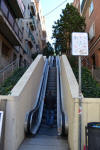 |
 |
| Oh dear ... not the warmest of welcomes after making the long (but partly assisted) climb! |
Following a hearty international-style breakfast in the Hilton's busy Mosaic restaurant, we set off by metro for our first sightseeing objective of the day. Parc Güell is situated on one of the slopes of Barcelona's Carmel Hill. Intended to be both a public park and a high-quality housing project, it resulted from a late-19th century collaboration between entrepreneur Eusebi Güell and architect Antoni Gaudí. The park opened in 1926, the year of the architect's death, and in 1984 became a UNESCO World Heritage Site.
Following our underground train journey, we had to
climb up to one of the park's three entrances, and convenient
escalator assistance was provided for parts of the ascent. Sadly, at
least one local vandal appeared not to approve of visitors and the
money that they bring into the city's economy (see right).
Another scrawled message on a public telephone pedestal, probably by
the same individual, suggested that as tourists we might care to
... erm ... Foxtrot Oscar. How very charming!
![]()
![]()
Happily, our efforts were rewarded when we entered the park itself, as the quirky and colourful structures, largely free of any concept of classical restraint, looked fabulous in the strong morning sunshine. The park became very busy during our visit, but fortunately never quite reached the stage of absolute pandemonium.
 |
 |
 |
 |
 |
 |
 |
 |
 |
 |
 |
 |
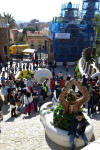 |
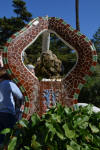 |
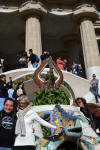 |
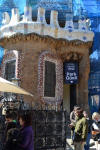 |
 |
 |
 |
 |
La Boqueria
We rode the Green Line back to Plaça de Catalunya and retraced the previous day's steps down La Rambla as far as La Boqueria. More properly the Mercat de Sant Josep de la Boqueria, this was another of Barcelona's thriving food markets and we thought it might also make a good lunch venue. And indeed, it almost certainly would have, except for the fact that the entire place was full to overflowing, including all of the locations where it would otherwise have been possible to sit down and eat. Nevertheless, the market was an interesting and photogenic place and I was glad that we had called by.
 |
 |
 |
 |
 |
 |
La Barceloneta
Pressing on along the waterfront and out into the seaside district of La Barceloneta, we hoped to position ourselves for a later journey on the Port Vell cable cars to Montjuïc, after attending to the still outstanding business of having some lunch. All of the bars and restaurants were especially busy on this Saturday afternoon, but we managed to squeeze into a suitable venue in which to rest our legs and enjoy some light food and a little liquid refreshment.
 |
 |
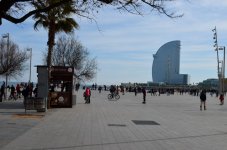 |
 |
 |
 |
After lunch, we walked across to the cable car terminus, or at least to the foot of the tower in which this was situated. Unfortunately there was a lengthy queue and with the relatively low frequency of journeys it soon became clear that by the time it was our turn to board, we would have wasted a huge chunk of the remaining daylight hours. We therefore opted for Plan B, which involved transferring to Paral-lel metro station with the intention of catching the funicular to Montjuïc. (I speculated that Paral-lel needed to be written like that, otherwise people would say 'para-yell'.) On arrival at the base station, our plans were once again thwarted as the funicular was not operating - aarghh! A replacement bus had been provided, however, and we finally managed to reach our troublesome objective at the third attempt.
Montjuïc to Plaça d'Espanya
 |
 |
 |
| The Olympic stadium on Montjuïc | ||
Montjuïc (literally, Jewish Mountain) is a hill that overlooks the harbour as well as much of the city itself. It would have been possible to continue our ascent to the summit - the location of the castle - by taking a gondola lift. Mindful of the difficulties experienced so far, the rapidly diminishing time available and the increasing amount of cloud cover, however, we decided not to push our luck. Instead we began by having a look at the Olympic stadium, originally built in 1927 and renovated in time for the summer games of 1992.
From there, we made our way to the impressive bulk of the Palau Nacional, originally built for the 1929 International Exhibition and now home to the Museu Nacional d'Art de Catalunya (also known as MNAC), the national art museum of Catalonia. From there it was an easy walk downhill alongside fountains and waterfalls to the impressive Plaça d'Espanya, also constructed for the great exhibition of 1929, although we did need to keep in mind the desirability of turning around periodically to see how the view of the Palau Nacional was looking from our current position.
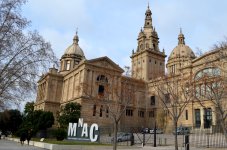 |
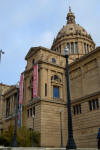 |
 |
 |
 |
 |
 |
 |
Five stops on the Green Line then saw us safely returned to base.
Final drinks and dinner
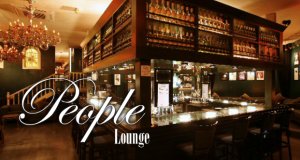 After
a short rest, we were ready for a final night on the town. Bruce had
identified a possible venue for cocktails, situated in the city's
Eixample neighbourhood - a district built in the 19th and
20th centuries and characterised by its grid system with chamfered
corners, which tended to create a more open effect at intersections
and unusual, octagonal-shaped city blocks. Having travelled to the
Urgell metro station, we quickly found our quarry but had to
take a little walk as, true to tradition in this part of the world,
it had not yet opened its doors. In the event, it turned out to be an excellent
choice, providing a welcoming and friendly venue for last-night
drinks prior to our return to the UK. A little later, we enjoyed a
tasty
Asian dinner in a busy nearby restaurant.
After
a short rest, we were ready for a final night on the town. Bruce had
identified a possible venue for cocktails, situated in the city's
Eixample neighbourhood - a district built in the 19th and
20th centuries and characterised by its grid system with chamfered
corners, which tended to create a more open effect at intersections
and unusual, octagonal-shaped city blocks. Having travelled to the
Urgell metro station, we quickly found our quarry but had to
take a little walk as, true to tradition in this part of the world,
it had not yet opened its doors. In the event, it turned out to be an excellent
choice, providing a welcoming and friendly venue for last-night
drinks prior to our return to the UK. A little later, we enjoyed a
tasty
Asian dinner in a busy nearby restaurant.
Although the trip was not quite over at this point, our return to the hotel effectively brought to an end this off-season road trip through Northern Spain. And what a week it had turned out to be: from regenerated and upbeat Bilbao, with its iconic modern museum, to San Sebastian, home of the wonderful pintxo bar culture; from Pamplona, so much nicer than portrayed in news reports about the bull run, into the Rioja wine region, with an unforgettable stay at Marqués de Riscal; and finally from historic Zaragoza to buzzing Barcelona, one of the liveliest destinations in Europe. Once again, it had been a truly fabulous trip despite a little bit of uncooperative weather, generating memories to be treasured and savoured for a very long time.